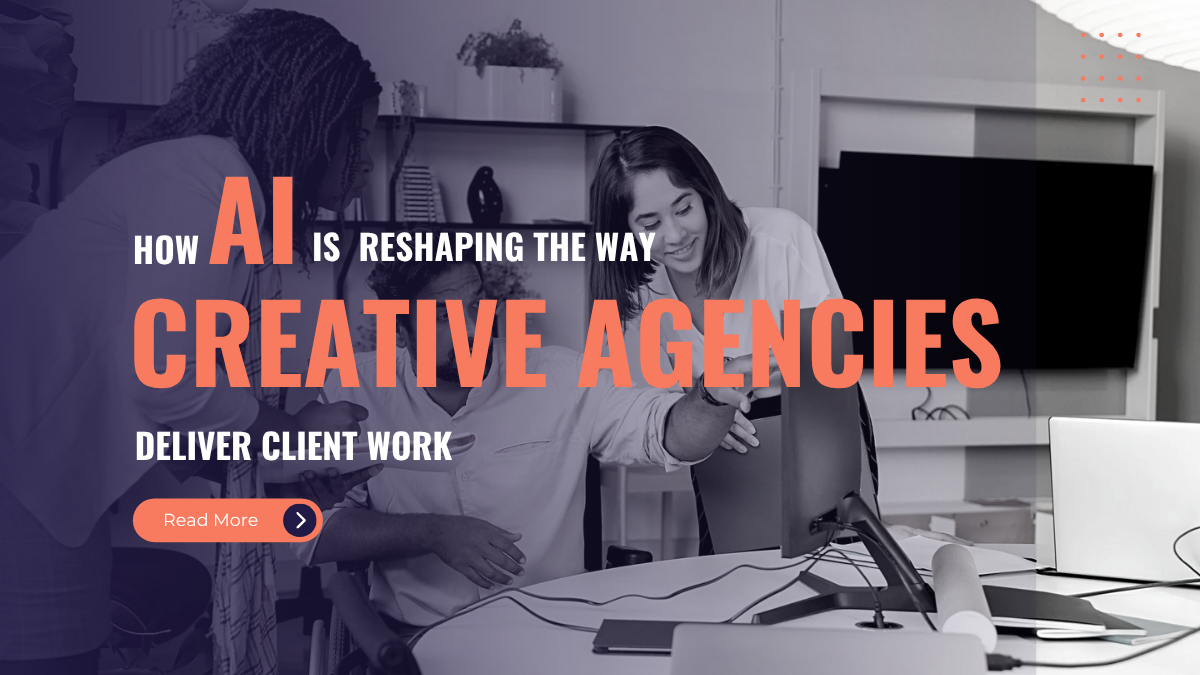Imagine this: your agency gets a client brief Monday morning. By Tuesday afternoon, you’ve delivered three concept directions, a dozen ad variants, a video preview, and a mini-report—all without breaking a sweat (or the bank). Magic? Nah. Just a creative team that knows how to harness AI like a pro.
AI isn’t just a buzzword anymore. It’s quietly—but radically—changing how creative agencies deliver client work. And if you’re still clinging to the old-school workflow of brainstorm → design → revise → deliver, you might be falling behind.
In this post, we’re breaking down exactly how AI is transforming the delivery process—from ideation to review—and what it means for you as an agency owner, project lead, or solo creative looking to scale smarter, not harder.
Why Creative Agencies Are Under Pressure to Deliver Smarter?
Let’s face it: the expectations on agencies today are… a lot.
Clients want more content, more personalization, and way faster turnarounds. Thanks to platforms like Canva, ChatGPT, and Runway, even non-designers can whip up creative assets in minutes. That means your value as an agency isn’t just “we make stuff”—it’s how fast, how smart, and how custom you make it.
Meanwhile, larger competitors are leaning into AI and automation to reduce costs and speed up delivery. If you’re not integrating these tools into your delivery model, you’re not just missing out on efficiency—you’re risking irrelevance.
The Workflow Revolution: From Brief to Delivery with AI
Let’s zoom in on where AI fits in your creative delivery pipeline—and how it’s reshaping each stage.
1. Ideation & Briefing
Good ideas are still king—but now, AI can help you generate more of them, faster.
Tools like ChatGPT, Midjourney, and Ideogram can instantly spin up campaign concepts, mood boards, and early visuals based on a short brief. It’s like having a junior creative who never sleeps and doesn’t get attached to their first draft.
Scenario: A client sends a vague prompt like “we want something fresh for Gen Z.” You plug that into your AI tool with a few parameters and boom—you’ve got five distinct creative directions, complete with sample headlines and imagery to discuss with your client that same day.
Use AI for width, not depth. Let it throw spaghetti at the wall—and then bring in your human touch to decide what sticks.
2. Production & Asset Creation
Here’s where the time savings really kick in.
With AI tools, you can automate the creation of marketing assets—without sacrificing creativity. Tools like Adobe Firefly, Canva’s Magic Design, and Runway’s Gen-2 let your team spin up visuals, graphics, and even video edits in a fraction of the usual time.
Example: Instead of designing 20 ad variants manually, you generate them using AI templates, then have a designer tweak them for brand alignment.
This doesn’t eliminate the need for humans—it repositions them. Your designers become brand stewards, not just asset factories. They’re making sure AI outputs feel right, not just look good.
3. Review, Feedback & Delivery
Review cycles are notorious bottlenecks. AI helps smooth that out.
From sentiment analysis on client feedback to version control via AI-enabled tools, you can streamline approvals and reduce the back-and-forth.
Some teams are even using AI to simulate how different audiences might respond to an ad—before it ever launches. That means faster decisions, fewer subjective debates, and way more confidence in your deliverables.
And when it’s time to deliver? Think real-time dashboards instead of static PDFs. Clients want living, breathing insights—and AI-powered reporting tools are making that standard.
One smart move? Use client management software like Agency Handy, especially designed for design agencies, to centralize client communication, briefs, revisions, and file delivery.
With streamlined ops in place, you can confidently scale your AI-accelerated workflows without drowning in admin work.
4. Post-Delivery Personalization at Scale
Here’s where you start to really wow clients.
AI lets you deliver not just a campaign, but versions of that campaign tailored to different audiences, geos, or platforms.
Say you’re launching a video ad campaign. With tools like Pika Labs or Descript, you can create dozens of variations—swapping visuals, changing text overlays, localizing voiceovers—without starting from scratch each time.
This level of personalization used to be a luxury. Now? It’s the new bar.
How to Start Using AI in Your Agency (Without Burning Out)
You don’t need a full AI overhaul. Here’s a simple roadmap:
- Audit your delivery flow: Where are your biggest time drains?
- Pick a pilot area: Try AI for one step—e.g., ad copywriting, or social graphic generation.
- Create an “AI sandbox”: Give your team space to experiment without client pressure.
- Train the team: Focus on prompt writing, QA skills, and brand consistency.
- Talk to clients: Frame AI as a way to deliver more value, not just faster work.
- Keep the human filter: Always QA your outputs for voice, ethics, and quality.
Watch Out for These Pitfalls
Before you go all-in on AI, avoid these common missteps:
- Generic output: Don’t let your work start looking like every other AI-driven brand. Inject brand voice and creativity.
- Blind trust in AI: Always review outputs for context, nuance, and brand tone.
- Tool fatigue: Too many tools, not enough training. Master a few, scale thoughtfully.
- Forgetting the human: AI is powerful—but your people are still your secret sauce.
Wrapping Up
AI isn’t about replacing your team—it’s about freeing them to do their best work.
Creative agencies that adopt AI smartly—without losing the soul of their brand or their client relationships—will thrive. The rest? Risk being replaced by speedier, savvier competitors.
So start small. Experiment with one workflow. Use tools that make your team sharper. And lean into platforms like Agency Handy that simplify delivery without the mess.
The future of creative delivery is here. It’s fast. It’s smart. And it’s got your agency’s name on it.

Sandeep Kumar is the Founder & CEO of Aitude, a leading AI tools, research, and tutorial platform dedicated to empowering learners, researchers, and innovators. Under his leadership, Aitude has become a go-to resource for those seeking the latest in artificial intelligence, machine learning, computer vision, and development strategies.


